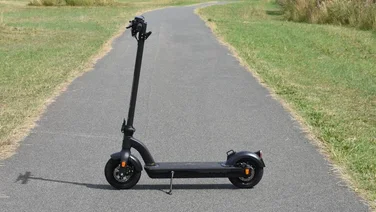To help us provide you with free impartial advice, we may earn a commission if you buy through links on our site. Learn more



The Aftershokz bone conduction headphones are designed to allow runners, cyclists and other active types to listen to music while still being able to hear everything that goes on around them. They also have a built-in mic and double as a hands-free headset. We’ve reviewed bone conduction headphones before, but those were for use underwater. While standard headphones work – like speakers – by making the air vibrate to carry sound, bone conduction headphones use the bones of your skull to transmit the sound to your inner ear.

The bone conduction transducers – which take the place of traditional headphone earpieces – rest against your cheekbones just in front of the ear, close to your mandibular joint. A plastic band joins the transducers, hooks over your ears and rests behind your neck. Just for once, we found this to be a perfect fit on our narrow size 7 skull, but it may be a tight fit for larger heads.
Each transducer has an 18mm rubber pad that clings to your face. Although they’re primarily designed to shake your bones, the pads are basically little speakers and you can hear sound coming from them through the air as well as through your skull. The air-conducted sound overlaying the more resonant bone-conduction makes the headphones sound tinnier than they should. It also means that these headphones are entirely unsuitable to wear on public transport – or even in the gym – without seriously annoying those around you.

Sound quality isn’t amazing, but it’s clear enough and even has some bass. It’s just rather unfortunate that the headphones sound their best if you block your ears. We also got better sound conduction when we wore them under a helmet. Either way, we wouldn’t use them to listen to music in favour of, for example, the Soundmagic E10 earphones, but your priorities are different when you want headphones to use while training. We were very pleased to be able to hear the sound of traffic – and even conversations between passing pedestrians – as we ran; having that awareness of your surroundings can be a lifesaver.
The only downside we found was that the headphones slipped back a little during our run, so ended up firing into our ears. We wouldn’t feel entirely comfortable cycling in heavily congested traffic wearing these, but they’re definitely safer than the traditional earphones worn by many cyclists, as they don’t prevent you from hearing the cars around you.

The Aftershokz weigh just 22g. The battery and control box weighs the same and can be securely clipped to your clothes. The control box houses – in addition to a power button – a mic and a call-end button, which doubles as a pause button for audio tracks. We’d have preferred a track skipping button. We’re not convinced that these headphones’ target audience will get much use out of its headset capabilities – we’re not much inclined to chat on the phone while we’re out for a run and it’s not a good idea while you’re cycling. The headphones are water-resistant rather than waterproof but we had no problems when we took them out in the rain.
The Aftershokz are a great idea if you’re seriously into your sport, want to listen to music but want to be safe while you’re doing it. They could be better, particularly when it comes to preventing sound from being carried through the air, which adds a tinny edge to the more rounded bone conduction audio. Currently, these headphones have few rivals that aren’t rebadging the same hardware, so the Aftershokz are the best option for anyone who wants to listen to music but needs to keep their ears open and their wits about them on the road.





